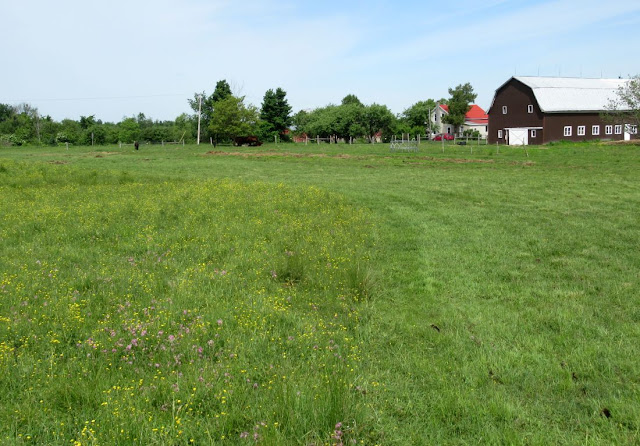I was wrong about there not being any baby fantail pigeons. I discovered this one high up on a shelf nest where I just hadn't noticed it before. It's a quiet, inactive bird and quite unlike some of the loud, hyperactive babies which have gotten themselves into trouble in the past. Maybe the parents are just keeping it so well fed it only lies there and burps all day:
Yellow Day Lilies began blooming amid a clump of Peonies. They appear every year without any assistance from me except to mow around the clump:
Out in the pasture, I saw these Common Fleabane flowers. There used to be more of them when I first moved here:
We were predicted to have nearly a week of idyllic weather, and one day my neighbor began lining up his haying equipment on my lawn:

Meanwhile, I began brush hogging the pasture. The tall weeds were hiding the horses' heads when I tried to see if they still had their muzzles on. Furthermore, I was spending several hours each day searching for lost muzzles. It took about six hours over two days to get it all bush hogged:
The wildflowers were pretty, but Buttercups were taking over. They are inedible and increasing because they kept dropping seed. You can see here the uncut portion on the left, and a mowed section on the right. The bush hog cuts rather high, so I am hoping it didn't disturb many bird nests:
But let's face it - a wildflower meadow is a beautiful thing. I wanted a photo of it before I chopped off all those flower heads:
Meanwhile, my two neighbors (a nephew and his uncle) began haying, then tedding. Tedding is when they turn over the cut hay to help it dry in the sun. They had to ted it multiple times before they began baling:
And then they attached the baler, followed by a hay wagon. This year he had a brand new kicker, which tosses the finished bales up in the air and into the wagon, where the uncle caught it and stacked it neatly. I had to take a number of photos to get one which showed an airborne bale, but you can see it in this picture, just entering the front of the hay wagon. Click on the photo if you want to enlarge it:
The horses and cattle ignored all the activity and lounged and grazed peacefully in the south field pasture:
The fantail pigeons were enjoying life in the barn. They are sociable birds with each other and also, in their own way, with me. They know where their food, water and bedding comes from:












No comments:
Post a Comment
Note: Only a member of this blog may post a comment.